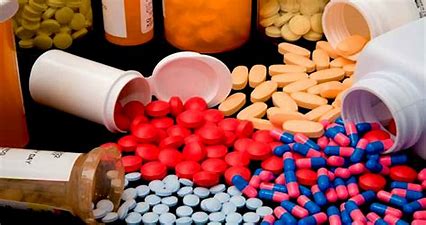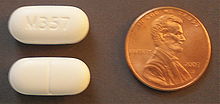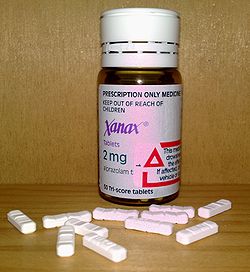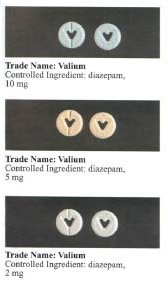
Taking prescription drugs that are not prescribed to you - or taking them in any way other than directed by a doctor is considered non-medical use or abuse and can be as dangerous as taking an illegal drug, such as cocaine or heroin. "Misuse" of a prescription drug is taking it to treat a medical condition but not as directed by a doctor or packaging; "abuse" is taking prescription drugs with the sole intention of getting high. When misused or abused, many prescription drugs can be as dangerous and addictive as "street" drugs.
The National Institute on Drug Abuse estimates that nearly 20 percent of people in the United States have used prescription drugs for non-medical reasons. According to a 2007 survey, prescription drug abuse occurs in more than 15 percent of U.S. high school seniors.
Popular pain-relievers of concern include hydrocodone (Vicodin, Lortab, Lorcet), oxycodone (OxyContin, Percocet, Percodan, or Tylox), and methadone, as well as a number of other drugs. Depressants of concern include clonazepam (Klonopin), alprazolam (Xanax), lorazepam (Ativan), zolpidem (Ambien), and diazepam (Valium). Stimulants of concern include methylphenidate (Ritalin) and amphetamines (Adderral).
Hydrocodone is a semi-synthetic opioid derived from two naturally occurring opiates, codeine and thebaine.  Hydrocodone is an orally active narcotic analgesic (pain reliever) and antitussive (cough suppressant). It is commonly available in tablet, capsule, and syrup form, and is often compounded with other analgesics like paracetamol or ibuprofen. Hydrocodone was first synthesized in Germany in 1920 and was approved by the Food and Drug Administration in 1943 for sale in the United States. Hydrocodone can be habit-forming, which leads to physical and psychological dependence, but the potential for addiction varies from individual to individual depending on unique biological differences. Sales and production of this drug have increased significantly in recent years, as have diversion and illicit use. In the U.S., formulations containing more than 15 mg per dosage unit are considered Schedule II drugs. Those containing less than or equal to 15 mg per dosage unit in combination with acetaminophen or another non-controlled drug are called hydrocodone compounds and are considered Schedule III drugs. Wikipedia - Hydrocodone
Hydrocodone is an orally active narcotic analgesic (pain reliever) and antitussive (cough suppressant). It is commonly available in tablet, capsule, and syrup form, and is often compounded with other analgesics like paracetamol or ibuprofen. Hydrocodone was first synthesized in Germany in 1920 and was approved by the Food and Drug Administration in 1943 for sale in the United States. Hydrocodone can be habit-forming, which leads to physical and psychological dependence, but the potential for addiction varies from individual to individual depending on unique biological differences. Sales and production of this drug have increased significantly in recent years, as have diversion and illicit use. In the U.S., formulations containing more than 15 mg per dosage unit are considered Schedule II drugs. Those containing less than or equal to 15 mg per dosage unit in combination with acetaminophen or another non-controlled drug are called hydrocodone compounds and are considered Schedule III drugs. Wikipedia - Hydrocodone
Oxycodone is an opioid analgesic medication synthesized from opium-derived thebaine.  It was developed in 1916 in Germany in an attempt to improve on the existing morphine, heroin, and codeine. OxyContin is Purdue Pharma's brand for time-release single-ingredient oxycodone oral medication and is generally prescribed for the relief of moderate to severe pain. It was first introduced to the U.S. market in 1996. By 2001, OxyContin was the best-selling non-generic narcotic pain reliever in the U.S., with sales exceeding $2.5 billion. It is generally better tolerated than morphine. In high doses, overdoses, or in patients not tolerant to opiates, oxycodone can cause shallow breathing, bradycardia, cold, clammy skin, apnea, hypotension, miosis (pupil constriction), circulatory collapse, respiratory arrest, and death. Wikipedia - Oxycodone
It was developed in 1916 in Germany in an attempt to improve on the existing morphine, heroin, and codeine. OxyContin is Purdue Pharma's brand for time-release single-ingredient oxycodone oral medication and is generally prescribed for the relief of moderate to severe pain. It was first introduced to the U.S. market in 1996. By 2001, OxyContin was the best-selling non-generic narcotic pain reliever in the U.S., with sales exceeding $2.5 billion. It is generally better tolerated than morphine. In high doses, overdoses, or in patients not tolerant to opiates, oxycodone can cause shallow breathing, bradycardia, cold, clammy skin, apnea, hypotension, miosis (pupil constriction), circulatory collapse, respiratory arrest, and death. Wikipedia - Oxycodone
Alprazolam, also known under the trade names Xanax, Xanor, Alprax, and Niravam, is a short-acting drug of the benzodiazepine class.  It is primarily used to treat moderate to severe anxiety disorders and panic attacks. Alprazolam was first
synthesized by Upjohn, and first released in 1981. Alprazolam is sometimes used with other recreational drugs to relieve the panic or distress of reactions to psychedelics such as LSD, and also to promote sleep in the "come-down" period following use of recreational drugs with stimulant or insomniac properties such as LSD, cocaine, or amphetamines. It is also often used in conjunction with marijuana or heroin to potentiate the relaxing effect. A large-scale nationwide USA government study conducted by SAMHSA found that, in the USA, benzodiazepines are, recreationally, the most frequently-used pharmaceutical, with 35% of drug-related visits to the Emergency Department involving benzodiazepines. Benzodiazepines are more commonly used recreationally than opioid pharmaceuticals due to their widespread availability. Wikipedia - Alprazolam
It is primarily used to treat moderate to severe anxiety disorders and panic attacks. Alprazolam was first
synthesized by Upjohn, and first released in 1981. Alprazolam is sometimes used with other recreational drugs to relieve the panic or distress of reactions to psychedelics such as LSD, and also to promote sleep in the "come-down" period following use of recreational drugs with stimulant or insomniac properties such as LSD, cocaine, or amphetamines. It is also often used in conjunction with marijuana or heroin to potentiate the relaxing effect. A large-scale nationwide USA government study conducted by SAMHSA found that, in the USA, benzodiazepines are, recreationally, the most frequently-used pharmaceutical, with 35% of drug-related visits to the Emergency Department involving benzodiazepines. Benzodiazepines are more commonly used recreationally than opioid pharmaceuticals due to their widespread availability. Wikipedia - Alprazolam
Diazepam is a benzodiazepine derivative drug, first released in the U.S. in 1963. It is commonly used for treating anxiety, insomnia,  seizures, muscle spasms, restless legs syndrome, obsessive compulsive disorder, alcohol withdrawal, and benzodiazepine withdrawal. It may also be used before certain medical procedures to reduce tension and anxiety, and in some surgical procedures to induce amnesia. It possesses anxiolytic, anticonvulsant, hypnotic, sedative, skeletal muscle relaxant, and amnestic properties. Benzodiazepines gained popularity among medical professionals as an improvement upon barbiturates and are also far less dangerous. Death rarely results from diazepam overdose. Diazepam is used to treat a wide range of conditions and has been one of the most frequently prescribed medications in the world for the past 40 years. Diazepam was the top-selling pharmaceutical in the United States from 1969 to 1982. Wikipedia - Diazepam
seizures, muscle spasms, restless legs syndrome, obsessive compulsive disorder, alcohol withdrawal, and benzodiazepine withdrawal. It may also be used before certain medical procedures to reduce tension and anxiety, and in some surgical procedures to induce amnesia. It possesses anxiolytic, anticonvulsant, hypnotic, sedative, skeletal muscle relaxant, and amnestic properties. Benzodiazepines gained popularity among medical professionals as an improvement upon barbiturates and are also far less dangerous. Death rarely results from diazepam overdose. Diazepam is used to treat a wide range of conditions and has been one of the most frequently prescribed medications in the world for the past 40 years. Diazepam was the top-selling pharmaceutical in the United States from 1969 to 1982. Wikipedia - Diazepam
Opioids, mostly prescribed to treat moderate to severe pain, include drugs such as Hydrocodone (Vicodin, Lortab) and Oxycodone (OxyContin). Opioids act on the brain by indirectly boosting dopamine levels in the brain regions that influence our perceptions of pleasure. This feeling is often intensified by abusers who snort or inject the drugs, amplifying their euphorigenic effects and increasing the risk for serious medical consequences, such as respiratory arrest, coma, and addiction. Combining opioids with alcohol can exacerbate these consequences.
Stimulants, prescribed to treat attention-deficit hyperactivity disorder (ADHD) and narcolepsy, include drugs such as Ritalin, Adderall, and Concerta. These prescription medications stimulate the central nervous system, with effects similar to but more potent than caffeine. When taken orally, as prescribed, these stimulants elicit a gradual and sustained increase in the neurotransmitter (brain chemical) dopamine, which produces the expected therapeutic effects seen in many patients. In people with ADHD, stimulant medications generally have a calming and "focusing" effect, particularly in children. However, because these medications affect the dopamine system in the brain (the reward pathway), they are also similar to drugs of abuse. For example, Ritalin, or methylphenidate, has much in common with cocaine - the two drugs bind to similar sites in the brain and both increase dopamine through the same molecular targets. When administered intravenously, both drugs cause a rapid and large increase in dopamine, which a person experiences as a rush or high. For those who abuse stimulants, the range of adverse health consequences includes risk of dangerously high body temperature, seizures, and cardiovascular complications.
Central Nervous System Depressants, typically prescribed for the treatment of anxiety, panic, sleep disorders, acute stress reactions, and muscle spasms, include drugs such as Diazepam (Valium), Alprazolam (Xanax), and Librium. Most CNS depressants act on the brain by decreasing brain activity, producing a drowsy or calming effect that is beneficial to those suffering from anxiety or sleep disorders. These drugs are also particularly dangerous when mixed with other medications or alcohol; overdose can cause breathing problems and lead to death. Although the newer sleep medications such as Ambien, Lunesta, and Sonata appear to have reduced dependence and abuse liabilities, they still react with some of the same receptors in the brain, so they may share some of the risks.
Prescription drug abuse has increased as the drugs have become easier to obtain.
For example, U.S. prescriptions for stimulants including those taken for ADHD increased from around 5 million in 1991 to almost 35 million in 2007. Prescriptions for opioid painkillers such as oxycodone (OxyContin) and hydrocodone (Vicodin) increased from 40 million in 1991 to 180 million in 2007. Most prescriptions are written for people who have a true medical need for these drugs. But many households have a drawer filled with old prescription bottles containing leftover drugs. Because prescription drugs have medical uses, teens often believe they are a safe alternative to street drugs.
As reported in the Partnership for a Drug Free America s annual tracking study:
1 in 5 teens has abused a prescription (Rx) pain medication
1 in 5 report abusing prescription stimulants and tranquilizers
1 in 10 has abused cough medication
Fatal prescription drug overdoses have nearly doubled in 5 years
Many teens think these drugs are safe because they have legitimate uses, but taking them without a prescription to get high or self-medicate can be as dangerous and addictive as using street narcotics and other illicit drugs. Hundreds of internet sites sell these drugs without a prescription. The drugs are bought directly from the pharmacy and there are never any questions asked and no IDs are required for purchase.
The non-medical use or abuse of prescription drugs has increased exponentially over the past 2 decades, and is occurring at epidemic proportions in almost every state. The problem is escalating and has become a major public health issue. When used properly, these drugs may relieve anxiety and pain, but when abused they can be lethal and just as addictive as other illicit drugs like heroin and cocaine.
In 2000, about 43 percent of hospital emergency admissions for drug overdoses (nearly 500,000 people) happened because of misused prescription drugs. This type of drug abuse is increasing partially because of the availability of drugs, including online pharmacies that make it easier to get the drugs without a prescription, even for minors. There may also be a perception, especially among younger people, that prescription drugs are safer than illegal street drugs. Most people don t lock up their prescription medications, nor do they discard them when they are no longer needed for their intended use, making them vulnerable to theft or misuse.
Other important factors have also recently contributed to the severity of prescription drug abuse, including drastic increases in the number of prescriptions written, greater social acceptance of using medications, and aggressive marketing by pharmaceutical companies.
Because prescription drugs act directly or indirectly on the same brain systems affected by illicit drugs, their abuse carries substantial abuse and addiction liabilities. They are most dangerous when taken to get high via methods that increase their addictive potential (e.g., crushing the pills, then snorting or injecting their contents, or combining them with alcohol or illicit drugs). Some people also take prescription drugs for their intended purpose, though not as prescribed, thus heightening the risk of dangerous adverse reactions; and still others may become addicted even when they take them as prescribed.
Nearly 7 million Americans are abusing prescription drugs more than the number who are abusing cocaine, heroin, hallucinogens, Ecstasy, and inhalants, combined. That 7 million was just 3.8 million in 2000, an 80 percent increase in just 6 years. Misuse of painkillers represents three-fourths of the overall problem of prescription drug abuse; hydrocodone is the most commonly diverted and abused controlled pharmaceutical in the U.S.
Because prescription drugs are safe and effective when used properly and are broadly marketed to the public, the notion that they are also harmful and addictive when abused can be a difficult one to convey.
It s no secret that drug abuse can be harmful and dangerous. Most people think serious problems are only caused by "club drugs" like ecstasy and GHB, and by "street drugs" like heroin and cocaine.
What a lot of people don t know is that prescription drug abuse (using medications for non-medical purposes) can be just as harmful and just as dangerous. Just because they re available at your local pharmacy, doesn t make them safe if they are misused or abused.
See, Statement by Nora D. Volkow, M.D.,
Director of the National Institute on Drug Abuse (NIDA), on Scientific Research on Prescription Drug Abuse before
the U.S. Senate Judiciary Committee, Subcommittee on Crime and Drugs, Wednesday, March 12, 2008.
See U.S. Department of Justice, Drug Enforcement Administration -
Drugs of Abuse | A DEA Resource Guide: 2024 EDITION.


